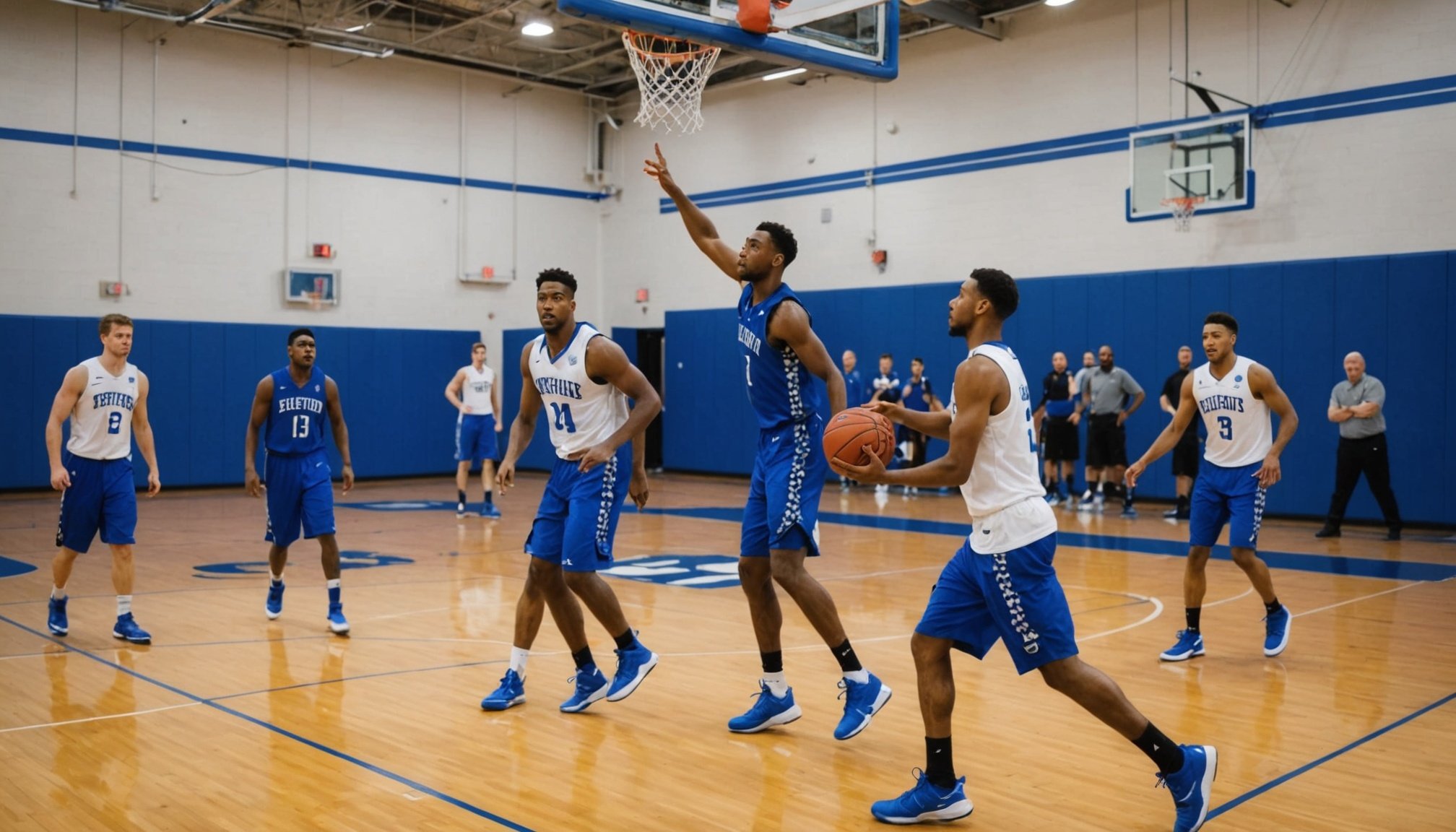Overview of Essential Conditioning Drills
Conditioning drills are crucial in basketball training, serving as exercises designed to increase players’ stamina, agility, and overall performance enhancement. These drills are vital for basketball players as they improve cardiovascular fitness and muscular endurance, which are essential for maintaining a high level of play throughout a game. Conditioning drills include activities that mimic actual game movements, ensuring players can sustain their energy and skills during an entire match.
The impact of conditioning on overall basketball performance is significant. Players with superior conditioning can react faster, cover more ground on the court, and execute plays with precision even as they tire. By incorporating conditioning drills into regular training, players can maintain their peak physical state, reducing the risk of injuries and ensuring they remain competitive.
Topic to read : Top Energy-Boosting Supplements for UK Basketball Players: Fuel Your Game Performance!
In the UK, basketball training is often tailored to meet local players’ specific needs. Tailoring drills ensures they address common physical demands and strategies used within the region. For example, incorporating more endurance-based activities can benefit UK players who might engage more in defensive strategies requiring prolonged physical exertion. This approach ensures each player gains maximum benefit, optimising their performance for games.
Aerobic Conditioning Drills
In basketball, Aerobic Training is crucial for building stamina and maintaining high performance throughout the game. It involves structured Endurance Drills, which are designed to enhance Basketball Fitness and ensure athletes can sustain energy.
Have you seen this : Essential Qualities UK Basketball Scouts Seek in Future Players: A Comprehensive Guide
Continuous Running Drills
Continuous running plays a key role in boosting cardiovascular endurance. It involves maintaining a steady pace over extended distances. For UK players, running distances of 3-5 kilometres at a moderate pace is typically recommended. This helps to condition the body to withstand the physical demands of a full game with less fatigue, thereby enhancing overall performance.
Interval Running
Interval training alternates between high-intensity bursts and periods of rest or lower intensity. This training improves endurance and replicates the stop-start nature of basketball. Suggested drills include sprinting for 30 seconds followed by a 1-minute jog. This simulates game scenarios and can be conveniently practiced at local tracks or parks, making it an effective strategy for basketball-specific fitness.
Shuttle Runs
Shuttle runs involve sprinting back and forth between markers, which mimic basketball’s quick changes in direction. This exercise enhances agility and speed. Variations can include changing the sprint distances or number of repetitions to fit different skill levels, providing flexibility in training regimens.
Strength and Resistance Drills
Strength training is critical in basketball as it enhances muscle development and overall performance. Incorporating strength and conditioning practices can significantly elevate a player’s game.
Importance of Strength Training
Building strength is fundamental to withstanding physical challenges on the court. It not only improves individual performance but also aids in injury prevention. Players with well-developed muscles can move more efficiently and have greater endurance during matches.
Core Exercises
Among resistance exercises, focus on those that bolster core stability. This includes planks, squats, and lunges, which are excellent for fostering balance and agility. A strong core is pivotal, aiding players in maintaining posture and executing powerful movements.
Safe Resistance Training
Safety is paramount. Begin with lighter weights and steadily increase resistance to avoid injuries. It is advisable to consult with a fitness professional when introducing new exercises into your routine. Regular monitoring of form and technique assures that strength training remains beneficial and doesn’t compromise health.
By deliberately shaping a structured routine centered on resistance exercises, athletes can augment both their stability and court performance, enjoying sustained benefits throughout their basketball careers.
Agility and Speed Drills
To enhance performance on the court, agility training and speed drills are essential components of a basketball player’s regimen. These exercises improve basketball footwork, increasing both quickness and overall movement efficiency.
Ladder Drills
Agility ladder drills are foundational for players looking to refine their agility. These drills focus on quick foot placements and precision. Players at beginner levels benefit from mastering the basic “One-Step” drill, while advanced players challenge themselves with complex patterns like the “Ickey Shuffle.” Engaging in these exercises sharpens reflexes, bolstering on-court performance.
Cone Drills
Cone drills significantly impact both speed and agility. Through controlled exercises such as the “Zig-Zag Drill,” players learn to maintain speed while maneuvering sharp corners. This drill allows utilisation of common resources, like local parks, for practice. By practising these drills, players can enhance their agility—a critical skill for successful gameplay.
Sprinting Techniques
Effective sprinting techniques are pivotal to basketball performance. By employing drills such as “Acceleration Sprints,” players enhance their explosiveness from a standstill. This drill encourages bursts of speed, ensuring quick recoveries and aggressive pursuits during games. Consistent practice perfects speed drills, contributing to more dynamic on-court movements.
Flexibility and Mobility Exercises
In the fast-paced game of basketball, maintaining optimum flexibility and mobility is essential for preventing injuries and enhancing performance. Engaging in regular flexibility training helps players improve their range of motion, which can lead to better execution of skills on the court.
Importance for Basketball Players
Basketball requires quick movements and direction changes, making flexibility and mobility crucial. It can not only enhance performance but also aid in injury prevention, particularly strains and sprains, which are common in this sport.
Recommended Stretching Routines
Incorporating specific mobility drills into daily training is key. Dynamic stretching before games, like leg swings and arm circles, preps the muscles for activity. Post-game, static stretching routines focus on major muscle groups such as hamstrings and quads to maintain flexibility.
Tips for Maintaining Mobility Throughout the Season
To keep mobility consistent, players should integrate foam rolling into their routines to alleviate muscle tension. Balance exercises are also beneficial, ensuring stability during those rapid movements. Remember, consistent flexibility training and targeted mobility drills will contribute to a successful and injury-free season.
Incorporating Local Resources into Training
Local training facilities in the UK offer a wealth of opportunities for basketball players eager to hone their skills. These local training facilities are not just spaces for practice but hubs of engagement and growth. Players can access a range of community resources that cater to various aspects of basketball training, from improving shooting accuracy to enhancing tactical understanding.
Among the numerous community resources, basketball clubs stand out as vital platforms. These clubs bring together enthusiasts and professionals, providing structured training sessions. Recommendations to consider include registering with basketball clubs that prioritise conditioning as part of their regimen. Engaging in conditioning can significantly boost a player’s performance capabilities, helping them to maintain stamina during games.
Training camps also serve as excellent avenues for development, often focusing on both physical fitness and mental conditioning. Such camps usually incorporate guidance from experienced coaches, offering tailored advice to tackle individual weaknesses.
Building a supportive training community is essential for UK basketball players. By forging connections with fellow players and trainers, athletes can share knowledge and spur each other toward improvement. This network fosters an environment of encouragement and shared aspiration, granting players the support they need to elevate their game.
Scheduling and Frequency of Conditioning Drills
Planning an effective training schedule is crucial for basketball players seeking to improve their conditioning. A well-structured schedule should consider seasonal training needs and aim to balance conditioning with skill training.
Seasonal Training
Off-season is the ideal time to focus on building a strong athletic foundation. During this period, incorporating three to four conditioning sessions per week can be highly beneficial. As the preseason approaches, players should gradually shift their focus towards skill training, blending it with two to three conditioning sessions weekly.
Frequency Recommendations
Consistency in training is key to maintaining peak performance. During the competitive season, athletes might reduce the frequency of conditioning drills to one or two times per week. This allows sufficient time for recovery while still reaping the benefits of cardiovascular and muscular endurance.
Balancing Conditioning with Skill Training
Striking the right balance between conditioning and skill training is essential for holistic player development. While conditioning enhances stamina and agility, skill training hones specific basketball techniques. Players should tailor their training schedules to alleviate fatigue, ensuring they are not overtraining and can perform optimally in both practice and games.











